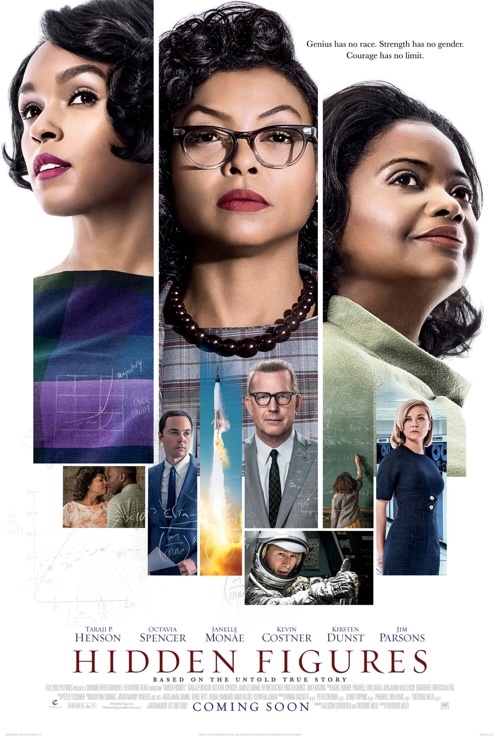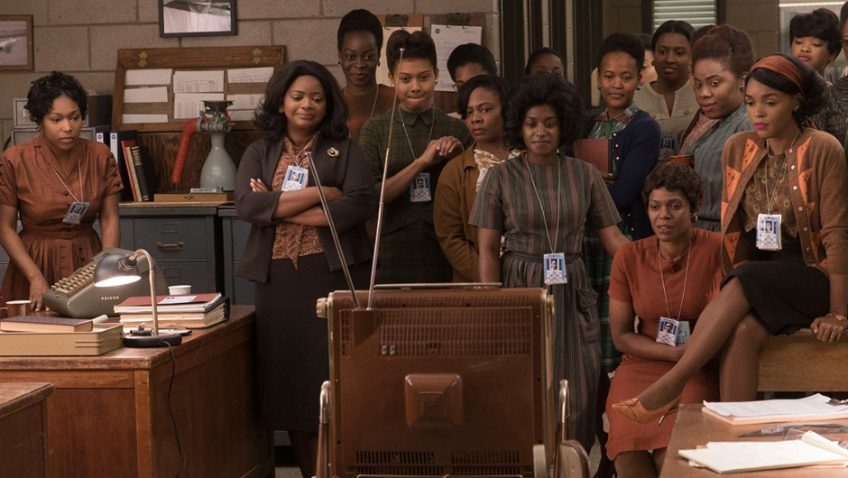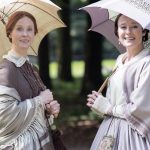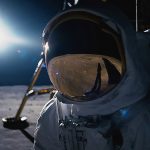Joyce Glasser reviews Hidden Figures (February 17, 2017)
Hidden Figures is a genuine feel-good movie that everyone over should see because it is so inspirational. We all know about the space-race in the 1960s that eventually saw astronauts including Neil Armstrong, Gus Grissom, Scott Carpenter and John Glenn go into orbit. Few people, however, know about the hidden figures behind these historic achievements. They toiled, in demanding, highly technical roles, at NACA (The National Advisory Committee for Aeronautics and then, in 1958, at NASA (The National Aeronautics and Space Administration). The surprise is not that these mathematicians and scientists called ‘computers’ were women: it is that, before Martin Luther King’s Selma to Montgomery march, or before the interracial couple, the Lovings, could legally marry in Virginia, these women were black.
 Hidden Figures, writer/director Theodore Melfi’s workmanlike follow-up to his directorial debut, St Vincent, is short on cinematic flair, but he tells a terrific, if necessarily simplified story that does not shy away from the mind-boggling mathematics. Melfi also gets the period details and casting just right.
Hidden Figures, writer/director Theodore Melfi’s workmanlike follow-up to his directorial debut, St Vincent, is short on cinematic flair, but he tells a terrific, if necessarily simplified story that does not shy away from the mind-boggling mathematics. Melfi also gets the period details and casting just right.
Based on the book by Margot Lee Shetterly, the film is set in 1961 when NASA, located in Langley, Virginia, was losing the space race to Russia. Three professionally dressed black women in high heels heading for work are stopped by a motorway cop while trying to repair their Chevrolet Impala.
We recognise one, Katherine Johnson (Taraji P Henson) from the prologue in which a school girl prodigy leaves a crowded room speechless when she solves a killer equation, guaranteeing her a university scholarship at the age of 13. Johnson was a school teacher and full time mother before joining NACA in 1953 as a ‘computer.’ The other two women are Mary Jackson (the singer Janelle Monáe, also co-starring in Moonlight), who held a degree in Mathematics and Physical Science and was a school teacher before joining NACA; and Dorothy Vaughan (Octavia Spencer) who was a maths teacher before joining NACA in 1943. They all had families.
The racist cop incident is a great set-up for what follows. When the surprised cop sees the women’s IDs, he muses, ‘I didn’t know they employed…’ only to have his sentence finished for him: ‘Women? They have quite a few women at the space programme. After realising that these black women are helping America beat the Russians, he offers them a police escort to Langley so they will not be late.
In the film the black, female employees are grouped in the West Computer Centre under a patronizing white supervisor, Vivien Mitchell (Kirsten Dunst). Vaughan is the supervisor of the 100 or so black ‘computers’ in all but title and salary. Her attempts to get the promotion she deserves are met with, ‘Y’all should be thankful you have jobs at all.’ But Vaughan sees the writing on the wall when NASA introduces the first, huge and intimidating IBM mainframes and is determined to make herself and her black colleagues indispensible. Noting the lack of qualified programmers, Dorothy attempts to borrow a FORTRAN book from the library. The book is only available in the White section of the library, so Dorothy obtains it illicitly and teaches herself FORTRAN. She then ensures that the other ‘computers’ learn programming too. This is an entirely true story and Dorothy really did become the first black supervisor, but it was at NACA in 1949, not at NASA in the 1960s.
Mary Jackson is a natural engineer, but in order to enter NASA’s training programme she needs additional course credits. It is not the burden of courses after a full day’s work or a neglected husband (Aldis Hodge) that are her biggest obstacles, but a segregated university. Jackson’s day in court is another air-punching moment, but even better is her entrance into the all-male, all-white classroom.
Katherine Johnson finds herself working under Al Harrison (Kevin Costner), director of the Space Task Group. She is the only woman (aside from Harrison’s sympathetic secretary) and the only black person in the department. As oblivious to differences in sex and race as he is to conflicts amongst his staff, Harrison is less a manager than an engineer under enormous pressure, who doesn’t suffer fools or time wasters. When he realises that Katherine’s long absences are due to the only black ladies’ room being half a mile away (at the West Computer Group), he hacks down the sign and segregates the toilets. It’s a great dramatic moment, but in reality the facilities had been segregated for three years when Johnson starts work at the STG.
But Johnson has bigger problems that a separate loo or coffee machine. Although she is brilliant at calculating and analysis, a jealous (and racist/sexist) head engineer, Paul Stafford (Jim Parsons), attempts to frustrate her at every turn. He refuses to allow Johnson’s name to appear on their joint research papers and he makes her job more difficult by refusing to issue her security clearance to meetings essential to her calculations. Katherine’s brilliance could not be overlooked, however, and it really is true that before the Friendship 7 launch on February 20, 1966, the astronaut John Glen requests that Johnson check the IBM calculations. In the film a nervous Glen (Glen Powell) instructs, ‘Let’s get the girl to check the numbers. If she says they’re ok, I’ll go.’
Katherine is also present in the control room during the problematic flight when the warning light goes on in the space capsule. Her quick thinking (she suggests that they leave the rocket attached to the heat shield for re-entry) saves the day.
It is refreshing to see a film where merit wins out over looks, race, sex or status. Just as Harrison, Glen, and a begrudging Stafford come to acknowledge Johnson’s brilliance, so does a potential suitor: a high ranking military officer who has met his match. At a party, Johnson and U.S. Army officer Jim Johnson (Mahershala Ali) are attracted to one another, but she walks away after he expresses skepticism about women and mathematics. Ali, who is Oscar nominated for his role in Moonlight, is disarming here, too, as a man determined not to screw up a second-chance.
Captions finish off this satisfying story. We learn that in 2015, aged 97, Johnson received The Presidential Medal of Freedom from President Obama and last year NASA opened the $30 million Katherine G. Johnson Computational Research Facility at Langley.
You can watch the film trailer here:




